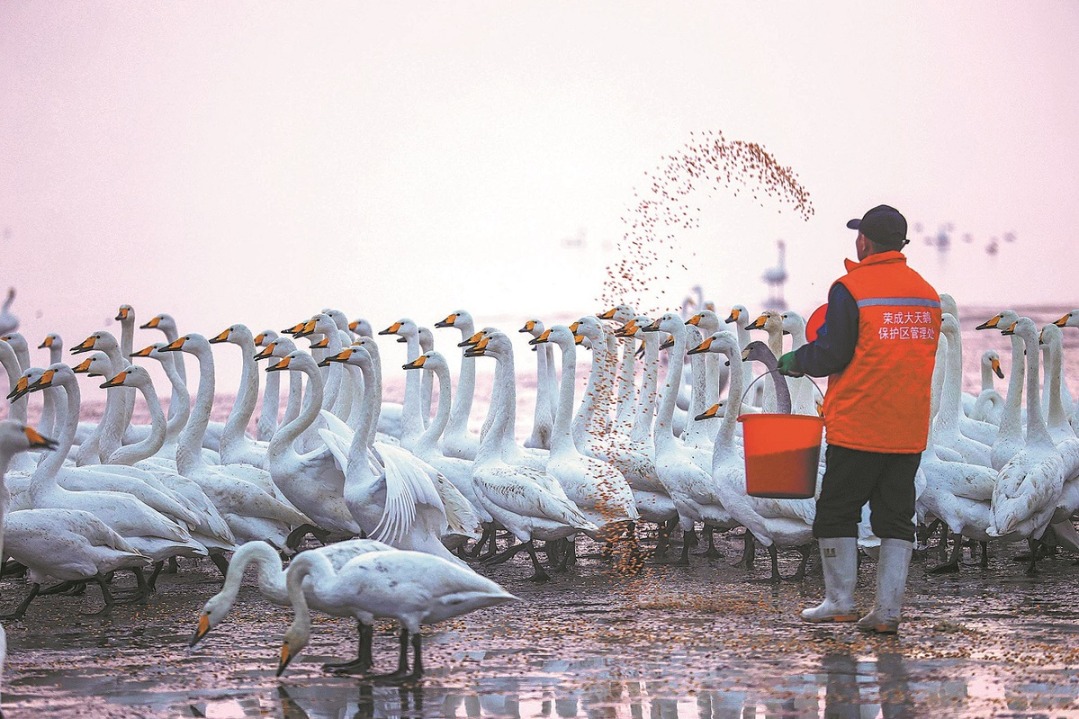Efforts to determine snares' toll no easy task


When Li Jing, the founder of Spoon-billed Sandpiper in China, a nonprofit organization dedicated to the conservation of migratory water birds — especially the critically endangered bird that gave it its name — took part in a regular survey of the spoon-billed sandpiper population in Taizhou and Wenzhou in Zhejiang province in November 2020, she noticed bird nets being set up around some fish ponds and intertidal mud flats. "We saw a few shorebirds trapped in the nets and realized it could be a serious issue," Li said.
As she was aware of conservation scientist Liang Dan's project studying the impact of direct human factors in the decline of shorebird populations, she contacted him and began cooperating with his team.
In March 2021, during a bird survey for Liang's project, Yang Ziyou and Wang Yudi, two employees of Li's organization, discovered a large number of nets supported by bamboo poles on the tidal flats of Wenzhou's Yueqing Bay, where razor clam seedlings were being cultivated.
"We saw many small black dots in the nets from a distance," Wang said. "When we looked carefully with our telescopes, we found that all the dots were birds entangled in the nets — some still alive but dying. We were shocked."
At Xinghua Bay in Fujian province, the research team witnessed similar scenes.
After hearing of their discoveries, Liang and four teammates visited the two bays to conduct further investigations. In April and May 2021, they spent one week at Yueqing Bay and four days at Xinghua Bay, trying to measure the nets and find out how many birds they killed.
But estimating the death toll was a challenge. "There were three main difficulties in conducting the survey," Liang said. "First, the area with the bird nets on the tidal flats was massive, and it was impossible for us to fully cover all of them."
Second, the tidal flats used for clam seedling cultivation were very muddy and difficult to traverse, making it impossible to approach the nets.
"We once saw a shorebird trapped in a net only 10 meters from the bank we stood on, and still alive," Liang said. A member of the team walked toward the net and attempted to save the bird, but just a few meters into the tidal flat, he found himself stuck in waist-deep mud. Liang said the man was pulled out by local fishermen.
Third, the nets were far away and the farmers did not usually remove birds from them, so they contained both dead and living birds, Liang said.
The team came up with a solution. They used drones to measure areas of nets from sampled areas, then counted birds in nets and identified the species within a specific period. Later, using that data and complex mathematical statistical models, the team estimated the deaths of about 14,000 migratory shorebirds in the two sites in April and May 2021. Liang said that to avoid overestimates, the research team returned to the two sites in April and May this year to optimize the survey plan and recalibrate the models being used.
- Crackdown urged on graft that affects ordinary people
- Inviting public opinions for 2026 China's Government Work Report
- Taiwan's Rednote ban exposes DPP's hypocrisy, political manipulation
- New tech aids safe air transport of lithium batteries
- New spacesuits debuted for Shenzhou XXI's first spacewalk
- Draft rules seek to safeguard network data security



































